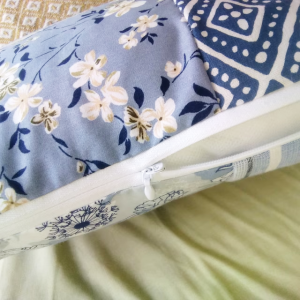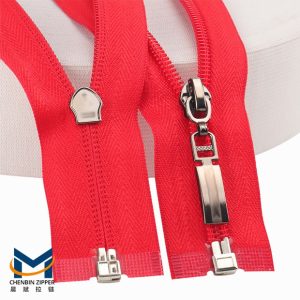
The Importance of Choosing the Correct Zipper
Choosing the perfect zipper is crucial when it comes to both functionality and aesthetics in handmade garments. Zippers not only provide convenience but also play a vital role in the overall design of the product. Selecting the wrong zipper can lead to frustration and disappointment. Therefore, it is essential to ensure that this small component is chosen wisely to meet the expectations of both the creator and the end user. By carefully selecting a zipper that complements the fabric and design of the garment, we can ensure that the final product is not only functional but also visually appealing. So, let’s dive into the world of zippers and discover the perfect match for your creations!
Types of Zipper Products
When it comes to zipper products, several types are available, each with its own unique characteristics and advantages. Understanding these types can help you make informed decisions that best suit your sewing projects.
Coil Zippers
Coil zippers consist of a continuous coil that is manufactured from nylon or polyester and provides great flexibility with not much weight. It makes for a great material in bags, light jackets, and other pieces of clothing. They sit flat against the fabric with no bulk because they operate so smoothly and are so soft to the touch. In addition to corrosion resistance, coil zippers are also a choice that can withstand weather and wear, making them ideal for outdoor projects and applications. Offering a spectrum of sizes and hues, their versatility suits both the function and aesthetics of each sewing project.
Metal Zippers
Metal zippers are very durable and strong. They are usually brass, aluminum, or nickel and are a more fashion-forward option than other zipper styles. These are commonly seen in denim, leather, and heavy-duty applications (they give a rugged look and solid closure). Metal zippers can visualize your styles, they look amazing in the design by adding a bit of sparking glam so it is primarily used where there is no necessity to care about weight such as fashion style. Although their heavy-duty capacity can be a load, the reliability they bring in harsh applications often outweighs this con. A metal zipper will imbue your projects with some grace as well as sturdiness.
Nylon Zippers
Most commonly, nylon zippers are known for their smooth movement and inexpensive cost. They are durable yet lightweight nylon coils that have a diverse variety of uses, from clothing to accessories. The style will depend on how these zippers similar to visible and invisible. Since they are easy to use and lightweight, nylon zippers usually get selected for the convenience of garments that need adjusting often or access. Moreover, they are available in countless sizes and colors, hence suitable for customization to match any sewing-based need.
Factors to Consider When Selecting a Zipper
Choosing the right zipper product involves several considerations that can significantly affect your project’s outcome. Here are the essential factors to keep in mind.
Fabric Type and Weight
Fabric type and weight play a major role in choosing the right zipper. So heavy fabric like leather or denim may need a beefy zipper—metal is good, whereas lighter fabrics including cotton or linen will be better suited for coil or nylon zippers. However, while choosing the zipper, it is equally important to ensure that at least it can handle the strain of the fabric without damaging with overall design aspect. Functional and aesthetic issues such as distortion and improper closures can arise specifically due to an incompatible zipper.
Intended Use of the Garment
Choosing the right zipper garment must also accompany consideration of how they would use the garment. In techniques for example clothes which are most likely to receive plenty of put on and tear, whether or not it is performed use or out of doors wear, then the heavy-duty metal or nylon zippers may be advisable. On the other hand, style-oriented fashion garments may be more appropriate for decorative zippers (including novelty shapes and designs). Knowing what the garment is meant for can determine how durable, how aesthetic the zip has to be, and what sort of function is required from it.
Length and Size of the Zipper
The length and size of the zipper are very important, have to pay attention. Using a zipper that is either too large or small for the garment can result in design shortcomings as well as altering the fit and look of the piece. When determining the right size, it is important to take a measuring tape and measure the section of your garment where you will be inserting your zipper. Zipper length provide a possible option to open the garment, but can not be shorter for achieving a minimalist look. Choosing the right size and length will enable the zipper to blend into your sew beautifully.
Color and Aesthetic
Finally, the zipper color and aesthetic should be consistent with the garment design. A bold zip can do both activate a design, or disrupt. Recommended Zipper Color The color palette of the fabric is an important aspect when it comes to choosing a zipper, and then you can properly visualize the vibe that you want your garment to reflect. They come in, you guessed it, all sorts of colors, giving you possibilities that can springboard into a paired project look. Invisible zips are great for when you want to keep things streamlined, and contrasting zips can add an element of interest!
Practical Tips for Sewing with Different Zipper Types
Techniques for Inserting Coil Zippers
Coil zippers are actually quite easy to sew into your projects when you know the right tricks. Start by placing the zipper tape accurately against the fabric edges, pinning or clipping it in place Use a zipper foot when sewing to get as close to the zipper teeth as possible without interfering with movement. This is also useful to produce a tidy end product. Zippers should be sewn from the bottom up, to maintain control and ensure that they open and close properly.
Also, when you come to the zipper pull, stop sewing with the needle in the fabric, lift up the presser foot, and carefully guide the zipper out of your way to continue to sew. This method enables smooth stitching without bunching of the fabric. When working with heavier fabrics, yes indeed you can use a longer length stitch to better hold the zipper. Finally, a few reverse stitches to reinforce where the zipper meets the fabric can give your assembly extra security.
Methods for Working with Metal Zippers
When it comes to metal zippers, these can be heavier and more rigid than a fabric zip. If you are using metal zippers, make sure to use a strong needle that is designed for heavier fabrics; the strength at its base will help with the zipper! For the first step, place the metal zipper teeth to align with the edges of the fabric and pin/baste it all around. A dedicated zipper foot will guide the fabric over those metal teeth with just enough clearance and a high degree of precision.
While sewing, please go slow because you do not want to break a needle on the metal teeth. When working on certain projects, such as denim or leather, the holes must sometimes be pre-drilled into the fabric so that the needle can drop through without making resistance. After adding the metal zipper and sewing it tightly, I also found it useful to press away from the zipper it helps with a crisp edge which gives a professional appearance to the garment.
Enhancing Your Sewing Projects with Quality Zipper Choices
When it comes to adding both style and utility, you can directly associate the end product with zipper products because these are some of the most important components that really make a difference. All in all, zippers are a cheap trick to make your piece look more finished and last longer. For example: choosing a decorative zipper with unique shapes or choose raw materials for a refreshing look to elevate the appearance, that makes your creation stand out from an ordinary piece.
Higher-quality zippers also tend to hold up longer. Companies that make zippers are known to have a wider collection available for any special needs, such as waterproof zippers for outdoor wear or heavy-duty zips to be used in bags. Getting accustomed to qualified zipper suppliers will assist in sourcing zippers that meet your style and quality expectations.
Knowing the uses of varieties of zippers makes it easy to decide which type is best for each project, granting you more success in sewing. Armed with this knowledge, along with correct installation practices, troubleshooting procedures, and routine maintenance will ensure a successful sewing experience that meets your creative needs.












